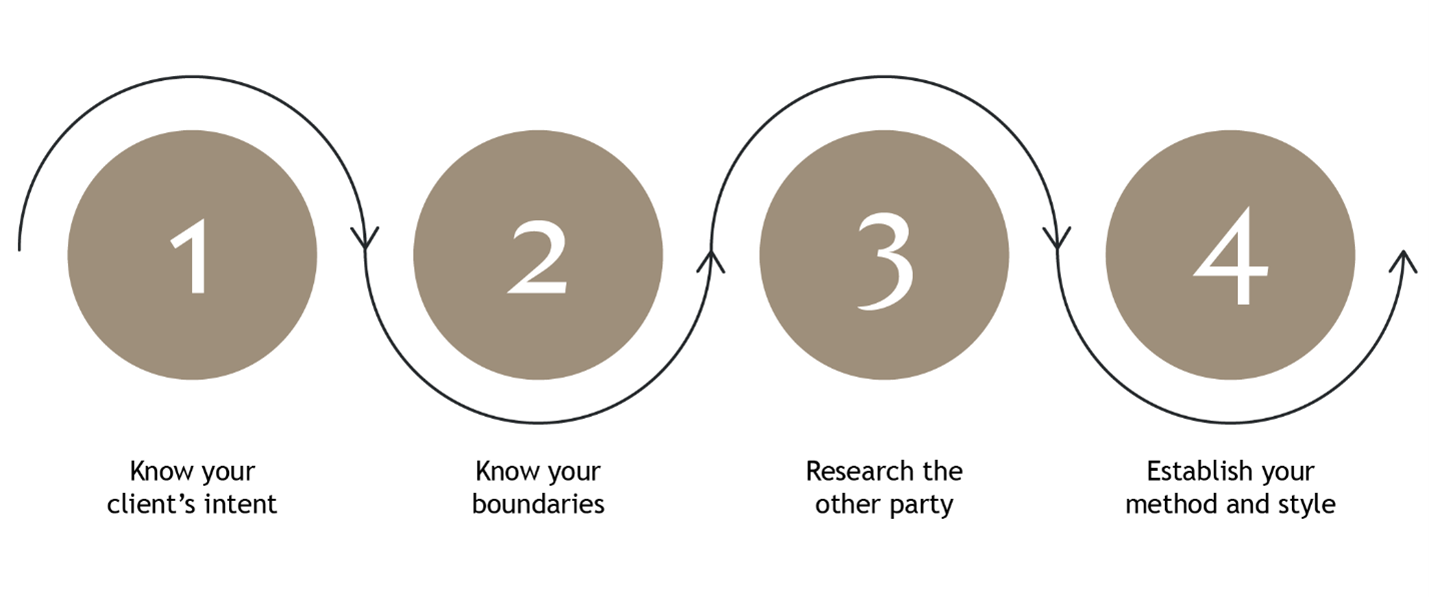Caroline Hayward and Stacy Ford provide guidance on what to consider when preparing for contract negotiation.
‘Give me six hours to chop down a tree and I will spend the first four sharpening the axe’ – Abraham Lincoln.
Similarly to felling a tree in the 1800s, you need to get out your honing stone when it comes to contract negotiation. This is because contract negotiation doesn’t just involve reading the terms of an agreement. That would be very boring. It involves discourse, persuasion and strategy. And to be good at contract negotiation, you need to be good at preparing for it.
Preparation is too often brushed aside due to complacency or competing priorities. Think about how many times you have attended a page turn and its apparent that the other party is looking at the contract for the first time! It doesn’t instil confidence and undermines their position. It’s a dull experience.
So how do you sharpen the axe (metaphorically of course…)?

1. Know your client’s intent
The first part of effective preparation involves client analysis. You need to understand your client’s intent and cut through any ambiguity.
- Client objectives: Understand what your client wants. Ask your client about their objectives, how they feed into their broader strategy, what are their priorities, and what is their desired (realistic) outcome from the negotiation.
- Commercial context: Understand the commercial setting. Ask your client about the commercial discussions that have occurred to date. Understand what the product or service is, the pricing, timeframes, key milestones, and scope of work.
- Clear instructions: Seek out clear instructions. Don’t accept ‘fly by the seat of your pants’ instructions. You need to pin down initial instructions and clear up any ambiguity before negotiations start. Where possible, instructions should be in writing.
2. Know your boundaries
It is important to understand your limits and to operate within your boundaries. As in-house counsel, you are entrusted to hold the line.
- Contractual limits: Understand from your client what is non-negotiable. You may already have standing instructions in relation to certain contractual provisions (or set out in a clause bank). You should understand from your client any initial points that they may be willing to concede on if negotiations become entrenched.
- Organisational limits: Understand your organisational limits. They will often relate to your organisation’s risk position – its risk appetite and tolerance on certain things. Consider whether you have standing instructions in relation to particular areas of risk or whether you need to involve assessment by other teams – your risk team or information security team etc.
- Approvals: Confirm with your client that all necessary approvals have been obtained, such as Board approvals and other financial approvals. This will avoid a headache later on.
3. Research the other party
In adversarial settings, such as sport, it is common sense to find out who you are up against. So why is this not ingrained in contract negotiation? Knowing the other party is essential to your strategy.
- Research (…reconnaissance): You don’t need to adorn camouflage, but try putting yourself in the other party’s shoes. Consider their intentions, their motivations, and how you would approach the negotiation if you were in their position. Look up their website, LinkedIn profiles, and find out where their legal team is based (consider time zone differences).
- Prior negotiations: Dust off the cobwebs on any previous matters with the other party. Look through mark-ups of prior agreements to determine what the other party generally accepts or rejects. Consider prior correspondence and comments to determine their negotiation style and tone.
- Win-win negotiation: A successful negotiation, particularly where there will be an on-going business relationship, is a ‘win-win negotiation’. The aim is for both parties to walk away feeling content. Discovering the other party’s motivations and tolerances will get you there faster than dredging through protracted negotiations.
4. Establish your method and style
Once you know your client’s intent and have assessed the other party, you can start to shape how you are going to negotiate.
- Stage setting: Set the stage for your negotiation. Consider what will be the most appropriate forum, whether that will involve email exchange of marked-up contracts, meetings, or both. Start with an exchange of marked-up versions and close out any tricky points with a meeting (a lot can be gained from just having a human interaction).
- Building depth: Your negotiation method should include depth. This involves having fall back positions. You should have an understanding from your research of any friction points. Layer your position by having alternatives thought out in advance.
- Professional courtesy: Be honest and courteous in your dealings with the other party. This will set the tone for the on-going business relationship. Be assertive when you need to be, but otherwise remain open to consideration. Try to use open body language as the other party will be more receptive.
Always be prepared!
Remember that preparation is fundamental to successful contract negotiation. It multiplies your prospects of success. We trust that you are now forearmed with practical guidance on how to best slice through your negotiations (again, metaphorically).
Further information
If you need further guidance on contract review or negotiation, please reach out to your KWM contact. If you are considering how to use or adopt LegalTech in relation to your contract processes, please contact our Innovation team.
Check out other insights from the Office of General Counsel team here and subscribe to KWM Pulse using the button below to stay across upcoming articles in areas of interest.









